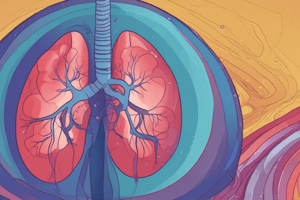Podcast
Questions and Answers
What is the relationship between lung compliance and elastance?
What is the relationship between lung compliance and elastance?
- Compliance is inversely proportional to elastance. (correct)
- Both are directly proportional to each other.
- Higher elastance leads to increased compliance.
- Elastance only affects lung compliance in saline conditions.
Which factor does NOT influence lung compliance?
Which factor does NOT influence lung compliance?
- Surface tension
- Elastic fibers
- Surfactant
- Airway resistance (correct)
What phenomenon causes the tendency of alveoli to collapse?
What phenomenon causes the tendency of alveoli to collapse?
- Elastic recoil in the lungs.
- The attraction between water molecules due to surface tension. (correct)
- Increased airflow during expiration.
- High levels of surfactant in the alveoli.
How do inspiration and expiration pressure-volume curves differ?
How do inspiration and expiration pressure-volume curves differ?
Which of the following statements about lung compliance is false?
Which of the following statements about lung compliance is false?
What is lung compliance primarily a measure of?
What is lung compliance primarily a measure of?
Which physiological property is primarily associated with lung elastic recoil?
Which physiological property is primarily associated with lung elastic recoil?
Which of the following conditions is likely to increase lung compliance?
Which of the following conditions is likely to increase lung compliance?
How is the pressure-volume curve of the lungs typically simplified?
How is the pressure-volume curve of the lungs typically simplified?
What percentage of the work of breathing is determined by lung compliance?
What percentage of the work of breathing is determined by lung compliance?
Fibrosis affects lung compliance in what manner?
Fibrosis affects lung compliance in what manner?
What does the transpulmonary pressure indicate during lung expansion?
What does the transpulmonary pressure indicate during lung expansion?
Which characteristic of lung compliance is most affected by diseases such as fibrosis or emphysema?
Which characteristic of lung compliance is most affected by diseases such as fibrosis or emphysema?
What is the primary effect of pulmonary surfactant on alveolar surface tension?
What is the primary effect of pulmonary surfactant on alveolar surface tension?
Which condition is characterized by a lack of surfactant, increasing the work needed for lung inflation?
Which condition is characterized by a lack of surfactant, increasing the work needed for lung inflation?
What defines the relationship between pressure, surface tension, and the radius of a bubble as per the Law of LaPlace?
What defines the relationship between pressure, surface tension, and the radius of a bubble as per the Law of LaPlace?
Which component of pulmonary surfactant significantly contributes to lowering surface tension?
Which component of pulmonary surfactant significantly contributes to lowering surface tension?
How does pulmonary surfactant affect lung compliance?
How does pulmonary surfactant affect lung compliance?
What is the consequence of insufficient surfactant during lung inflation?
What is the consequence of insufficient surfactant during lung inflation?
What role does lung elastance play in the context of pulmonary surfactant?
What role does lung elastance play in the context of pulmonary surfactant?
Which of the following statements regarding the pressure-volume curve is correct?
Which of the following statements regarding the pressure-volume curve is correct?
How does increased lung compliance affect elastic recoil?
How does increased lung compliance affect elastic recoil?
Which factor primarily opposes the inflation of alveoli?
Which factor primarily opposes the inflation of alveoli?
What phenomenon explains the non-linear relationship of dynamic resistance during breathing?
What phenomenon explains the non-linear relationship of dynamic resistance during breathing?
Which of the following correctly describes the effect of surfactant on lung compliance?
Which of the following correctly describes the effect of surfactant on lung compliance?
Which of the following phenomena describes the inability of the lungs to behave as a perfect elastic system?
Which of the following phenomena describes the inability of the lungs to behave as a perfect elastic system?
What primarily determines airway resistance in the respiratory system?
What primarily determines airway resistance in the respiratory system?
Which mechanism contributes to increased airway resistance during an asthma attack?
Which mechanism contributes to increased airway resistance during an asthma attack?
What type of muscle contraction is responsible for bronchoconstriction?
What type of muscle contraction is responsible for bronchoconstriction?
Which of the following factors would NOT cause increased airway resistance?
Which of the following factors would NOT cause increased airway resistance?
How can airway resistance be affected by the contraction of smooth muscle?
How can airway resistance be affected by the contraction of smooth muscle?
Which class of medications is used to promote bronchodilation?
Which class of medications is used to promote bronchodilation?
What is a common physiological outcome of airway resistance increasing?
What is a common physiological outcome of airway resistance increasing?
Which of the following conditions can result in dynamic small airway closure?
Which of the following conditions can result in dynamic small airway closure?
How does increased lung compliance affect the work of breathing?
How does increased lung compliance affect the work of breathing?
What is the primary effect of lung fibrosis on lung compliance?
What is the primary effect of lung fibrosis on lung compliance?
What role does elastic recoil play during expiration?
What role does elastic recoil play during expiration?
Which disease is associated with decreased lung compliance?
Which disease is associated with decreased lung compliance?
What does a pressure-volume curve indicate about lung characteristics?
What does a pressure-volume curve indicate about lung characteristics?
What is the impact of emphysema on lung compliance?
What is the impact of emphysema on lung compliance?
How much of the work of breathing is determined by lung compliance?
How much of the work of breathing is determined by lung compliance?
What is indicated by transpulmonary pressure increasing?
What is indicated by transpulmonary pressure increasing?
What is the main function of pulmonary surfactant in the alveoli?
What is the main function of pulmonary surfactant in the alveoli?
Which of the following is NOT a characteristic of pulmonary surfactant?
Which of the following is NOT a characteristic of pulmonary surfactant?
How does a lack of pulmonary surfactant affect lung function in conditions like NRDS?
How does a lack of pulmonary surfactant affect lung function in conditions like NRDS?
According to the Law of LaPlace, what factors determine the magnitude of inward-directed pressure in a bubble?
According to the Law of LaPlace, what factors determine the magnitude of inward-directed pressure in a bubble?
What happens to lung compliance when surfactant levels are decreased, such as in ARDS?
What happens to lung compliance when surfactant levels are decreased, such as in ARDS?
What role do DPPC molecules play in the function of pulmonary surfactant?
What role do DPPC molecules play in the function of pulmonary surfactant?
In conditions like New-Born Respiratory Distress Syndrome (NRDS), the lack of surfactant primarily leads to what physiological issue?
In conditions like New-Born Respiratory Distress Syndrome (NRDS), the lack of surfactant primarily leads to what physiological issue?
What is the primary composition of pulmonary surfactant?
What is the primary composition of pulmonary surfactant?
Flashcards are hidden until you start studying
Study Notes
Lung Compliance
- Change in volume per unit change in pressure
- Ability for lungs to be stretched
- Measure of elastic resistance
Elastic Recoil (Lung Elasticity)
- Ability for lungs to rebound
- Key driving force during expiration
Pressure-Volume Characteristics
- Lung characteristics can be simplified by examining them outside of the body
- As transpulmonary pressure increases, lung volume increases
- Pressure-volume curve represents both elastic and airway resistance properties of the lungs
- This is often simplified to a single line
Compliance and Elastic Recoil: Clinical Implications
- Many diseases affect lung compliance and it is a useful clinical measure
- Fibrosis results in a stiffer lung with less compliance
- Emphysema results in increased lung compliance
- Compliance accounts for 65% the work of breathing
- A lung with low compliance requires more work for breathing
Factors Affecting Lung Compliance
- Surface tension, elastic fibres, surfactant
- Compliance is inversely proportional to elastance
- High compliance = less elastic recoil
- Low compliance = more elastic recoil
Alveolar Surface Tension
- Water molecules are charged and attracted to each other
- This contributes to the tendency of alveoli to collapse
- This resists alveolar inflation
Pulmonary Surfactant
- Synthesised by type II alveolar cells
- A lipoprotein complex (mixture of lipids and proteins)
- Amphilic (both hydrophilic and hydrophobic)
- Stabilises alveoli and increases lung compliance
Pathophysiology
- New-born Respiratory Distress Syndrome (NRDS) - lack of surfactant
- Acute Respiratory Distress Syndrome (ARDS) - inactivation of surfactant
### Airway Resistance
- Friction between air and airway walls
- Primarily depends on the airway's diameter
- Smallest bronchi have the largest total cross-sectional area, so they have the least resistance
- Medium-sized bronchi have the highest resistance
- Bronchoconstriction, mucus, fluid and oedema increase airway resistance
Lung Compliance and Elastic Recoil
- Compliance is the ability of the lungs to stretch (change in volume per unit change in pressure)
- Elastic recoil is the ability for lungs to return to their original shape, driven by elastic fibres
- Pressure-volume curves represent both elastic and airway resistance properties
- Fibrosis makes lungs stiffer and less compliant
- Emphysema increases lung compliance
- The work of breathing is determined by lung compliance. Low compliance requires more work.
Alveolar Surface Tension
- Water molecules are charged, leading to a tendency for alveoli to collapse
- This collapse is resisted by alveolar inflation
- Pulmonary surfactant, produced by type II alveolar cells, is a lipoprotein complex
- Surfactant is amphiphilic (hydrophilic and hydrophobic) and stabilises alveoli, increasing lung compliance.
- In New-Born Respiratory Distress Syndrome (NRDS), there is a lack of surfactant
- In Acute Respiratory Distress Syndrome (ARDS), surfactant is inactivated.
### Importance of Surfactant
- Surfactant lowers elastic recoil due to surface tension, increasing compliance and decreasing the work of breathing.
- Without surfactant, the opening pressure of alveoli is high, making it difficult to inflate, and the deflation stability of the lungs decreases.
Studying That Suits You
Use AI to generate personalized quizzes and flashcards to suit your learning preferences.





